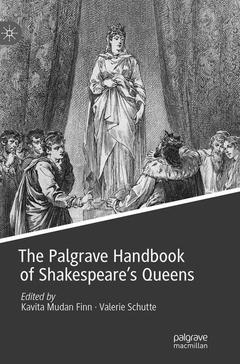1. Introduction.- I. General Studies.- 2. Stagecraft and Statecraft: Queenship and Theatricality on the Shakespearean Stage.- 3. Shakespeare's Queens and Collective Forces: Facing Aristocracy, Dealing with Crowds.- II. Queenship & Sovereignty.- 4. "I trust I may not trust thee": Queens and Royal Women's Visions of the World in King John.- 5. Cordelia, Foreign Queenship, and the Commonweal.- 6. "Tremble at patience": Constant Queens and Female Solidarity in The Two Noble Kinsmen and The Winter's Tale.- III. Queenship & Motherhood.- 7. "...to beare the name of a queene": Eleanor, Duchess of Gloucester, and Lady Macbeth: Queens and Motherhood.- 8. Womb Rhetoric: The Martial Maternity of Volumnia, Tamora, and Elizabeth I.- 9. "Good queen, my lord, good queen": Royal Mothers in Shakespeare's Plays.- IV. Queenship & Rhetoric.- 10. Margaret of Anjou and the Rhetoric of Sovereign Violence.- 11. "I can no longer hold me patient!": Margaret, Anger, and Political Voice in Richard III.- 12. Shakespeare's Cleopatra as Metatheatrical Monarch.- V. Absent/Missing Queens.- 13. "Nothing Hath Begot My Something Grief": Invisible Queenship in Shakespeare's Second Tetralogy.- 14. The Queen's Two Bodies in The Winter's Tale.- 15. The Political Aesthetics of Anne Boleyn's Queenship in Henry VIII, or All is True.- 16. The Fortification and Containment of Queen Elizabeth I's Rhetoric and Performance in Shakespeare and Fletcher's Henry VIII.- VI. Staging Queens & Contemporary Politics.- 17. The Princess' Political Mission in Love Labour's Lost: The Embassy to get Aquitaine and "all that is" Navarre's.- 18. Katherine of Aragon, Protestant Purity, and the Anxieties of Cultural Mixing in Shakespeare and Fletcher’s King Henry VIII.- 19. “The Ambition in my Love”: The Theatre of Courtly Conduct in All’s Well That Ends Well.- VII. Queenship & Intertextuality.- 20. As Wise as She is Beautiful: Reconciling Shakespeare’s Fairy Queen and Spenser’s Faerie Queene.- 21. The Princess of France: Difference and Dif(fé)rance in Love’s Labour’s Lost.- 22. “A gap in nature”: Re-writing Cleopatra Through Antony and Cleopatra’s Cosmology.- 23. En un infierno los dos: Catherine of Aragon and Anne Boleyn in Shakespeare & Fletcher’s Henry VIII and Calderón’s La cisma de Inglaterra.- VIII. Performing Queenship.- 24. Margaret of Anjou: Shakespeare's Adapted Heroine.- 25. The Bard, the Bride, and the Muse Bemused: Katherine de Valois on Film in Shakespeare’s Henry V.- 26. The “squeaking Cleopatra boy”: Performance of the Queen’s Two Bodies on the Early Modern Stage.




